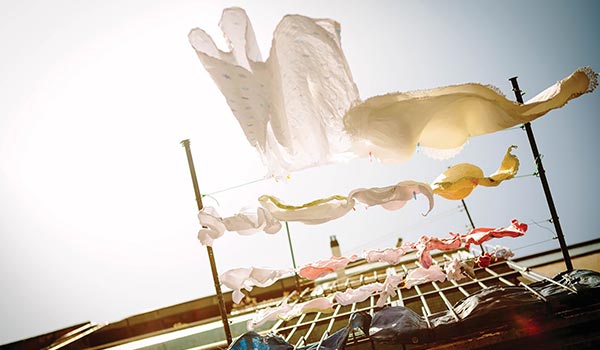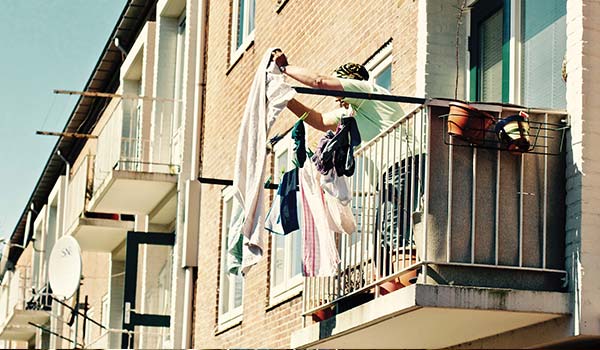Subtotal: $
Checkout-

Tolstoy’s Case Against Humane War
-

Edna St. Vincent Millay’s “Conscientious Objector”
-

Oscar Romero
-

The Martyr in Street Clothes
-

Editors’ Picks Issue 24
-

Van Gogh Comics
-

Boys Aren’t the Problem
-

The Woman Who Carried Me
-

Samuel Ruiz García
-

Christian Nonviolence and Church History
-

American Muslims: Race, Faith, and Political Allegiance
-

Ministers and Magistrates
-

Pick the Right Politics
-

Editor’s Postscript: Notes from the Lockdown
-

Readers Respond: Issue 24
-

Family and Friends: Issue 24
-

What Goes Up
-

The Politics of the Gospel
-

What Are Prophets For
-

A Letter to the Emperor
-

The Anabaptist Vision of Politics
-

Jakob Hutter
-

The Bruderhof and the State
-

Saint Patrick
-

Reading Romans 13 Under Fascism
-

Holding Our Own

Living with Strangers
The isolation built into mainstream American life is bad for the soul.
By D. L. Mayfield
March 25, 2020
Every time I drive past an apartment complex, I feel an ache in my chest because I cannot live there – not in all of them. And yet I dream of making a home in each of these hidden-away spaces where people are crammed in right up next to each other. My recollections of my many apartments over the years are all dreamy: sunlight filtering through windows, breaking bread with neighbors, being welcomed into communities culturally and socially so different from each other and from the ones I’d grown up in.
My husband remembers it differently. He reminds me that in certain seasons we were so busy responding to outside demands that we were like ghosts, slight impressions on the microcosm of life in a complex. Other times we were frightened by the sounds of our neighbors screaming in rage, wailing in sorrow, taking their fights out into the corridors, people in mental-health crisis and people trying to wash away their sadness with gallons of vodka or pipes full of hard drugs. The sickly-sweet smell of passing out, of numbing out, of trauma breaking through. Or the nights when neighbors would sail into our apartment without knocking, when our small living room was another extension of the outdoors – so little privacy, all exposed, no respite for the introverts, constant invitations into spaces and feasts and stories.

Photograph by Jason Briscoe (public domain)
When my husband reminds me of these experiences, I can start to remember the nuances. But it all goes out the window as I drive slowly past a complex, full of peeling paint and mothers bouncing babies on their knees, a big sign saying “Now Accepting Applications.” I want to live there; I want to sit around and see how people go about their lives; I want to become a known entity, benign as a mailbox, a staple of the community, a watchful grandmother. I want to do this in every apartment complex in America. I want to know and be known by every person who lives in these spaces that cater to those working very hard to make it. That’s not too much to ask, is it? Sometimes I tell this to my husband, and he just shakes his head at me. “Danielle,” he says, full of kindness, full of wisdom. “You can’t be neighbors with everybody. You can only be a good neighbor to a few. So pick those neighbors on purpose.”
I want to become a known entity, benign as a mailbox, a staple of the community, a watchful grandmother.
Philoxenia, the Greek word for hospitality, means “love of the stranger.” Much of the hospitality shared on my social-media feeds is geared toward family, friends, and church groups. Often it revolves around immaculately decorated houses or complicated recipes pulled off with aplomb. It is about a hostess with killer hair and a cozy house. For some it’s just a way of expressing themselves; for others, already drowning in bills, in children, in an inability to get out of bed to tidy up, this kind of hospitality is a millstone around their necks.
There’s a story about a woman, Kristin Schell, who put a picnic table in her front yard, painted it a bright turquoise, and sat at it until she started meeting some of her neighbors. She wrote a book about this table, colored the same shade that a multitude of Christian inspiration books also mysteriously display. The turquoise table is not a bad idea, not at all. It was a bold move to break free from the isolation that the American suburban experience is built on. It was one woman making a claim that the dream was too narrow for her. She needed a flag, a bright turquoise one, that she could plant as a sign that there was more to life than the kingdom she was building inside. She sat at the table and invited others to join her, and relationships were forged.
This woman reached out to the strangers around her, and it resonated with others who, I assume, felt that same pull toward neighborliness. But is it true hospitality, I wonder? Does it get to what love of the stranger really means? In order to love the stranger we have to love the people who are most estranged from us. And that would involve upending the entire system, how neighborhoods and shopping centers and schools and churches are all built by people wanting to be with those who are just like them. A turquoise table simply won’t reach far enough if the composition of your neighborhood is the result of targeted systems of segregation. A turquoise table will not do if your suburb – your neighborhood – is built on the backs of the excluded.
Xenophobia is the opposite of hospitality. In Greek, it means “fear of the stranger.” It’s in the very air we breathe: it’s built into our mortgage contracts, our Constitution, our foreign policy, our immigration system, and the speeches that elect our politicians. It’s the large backyards and the white picket fences, the parents googling a school’s rating and buying houses based on the result, Facebook groups casting judgment on “suspicious” males wearing hoodies, police brutality that disproportionately affects black and brown people, locking our car doors as we drive through a neighborhood we have no curiosity about. The fear of the other is so strong and so systemic that it might take something more than a good dinner party to upend it.
Born and raised in suburbs and semirural areas, I did not grow up viewing my neighbors as people worthy of special attention. The stereotypical wave and smile was usually the extent of our relationship with them, especially as my family moved every two to three years. But the exceptions stand out vividly. When I was a senior in high school my mother made me check on our elderly neighbor nearly every day. “Make sure she’s still alive,” my mom would cheerfully tell me as she pushed me out of the house. I would knock on Marguerite’s door, and I still remember my prayers. “Oh Lord, help me not to be the one to discover her body. Please let today not be that day.”
I got an education in neighborliness – both the awkwardness and the blessing of it.
It never was that day, thankfully. Instead, I got an education in neighborliness, both the awkwardness and the blessing of it. Marguerite, who was in her late eighties, was like no one I had ever met. She was what my parents would have described as a liberal – the radio constantly tuned to NPR, the New York Times always folded next to her chair. Her house was mostly books and houseplants. I don’t remember what we chatted about, but it usually revolved around books. My parents would invite her over for Christmas and she would come, sitting somewhat stiffly through all our prayers. When I left home for new adventures, Marguerite gave me an ornate brocade chair and a broken uke-banjo. Delightful, completely impractical gifts from a woman who gave me a glimpse into an alternate way of living. Surrounded by knowledge, surrounded by the world, and yet still capable and desirous of community.

Photograph by Matthias Zomer (public domain)
But sometimes we need help to swim against the current of isolation that moves beneath our way of living. My friend Breanna lives half the world away, in Southeast Asia. She upended her life to be a learner. She writes beautifully about how living in cramped, close quarters, with all her neighbors knowing everything about her business, has enabled her to see the loneliness of the American landscape when she returns home for a visit. Everyone with their houses in the suburbs, their garages, their swing sets in the backyards. They are alone, Breanna realizes now, and they don’t even know it. She tries to explain this to her neighbors in Southeast Asia, and they are shocked that most people in the United States don’t know their neighbors. They feel sorry for us.
My neighbors born in other countries have communicated the same to me many times over. When we moved into our current neighborhood, outsiders warned us about the crime rates. And while some things were hard to get used to – including celebrations that went into the wee hours and a neighbor who confused the gas pedal with the brakes and drove his car into my daughter’s bedroom – overall we felt incredibly safe. It was a space filled with people who had not grown up with the dominant cultural values of autonomy and privacy. We have found immense safety in community, in knowing people. And the opposite is also true: fear laces all of our privacy and autonomy, fear that comes from being estranged from the people in our neighborhoods.
When I drive around neighborhoods with large homes and spacious yards, I feel a rush of questions: How do people pay for those huge spaces? How do they reconcile having that much room, that much stuff, with the realities of others who struggle to pay the water bill, while the shelters are stuffed to overflowing with homeless families? But there’s also a sense that this loneliness is on purpose, though we never say this aloud. That we believe people are supposed to be affluent, and they are supposed to be autonomous – even if it turns out to be very bad for their souls. There’s a reason my heart leaps within me whenever I see another large, battered apartment complex with a sign proclaiming a room for rent.
There’s a reason I want to move in there, immediately. It’s because these are some of the very few spaces in our country and our culture where interdependence is a necessity, where it is a discipline that can be cultivated. These apartment complexes mirror the world of the biblical writers, who would be baffled by how individualism, consumerism, and affluence have shaped our communities – including how we live, eat, shop, educate our children, and worship.
Just like affluence, autonomy seems alluring but proves to be poisonous. Its ill effects can be hard to see clearly unless we are given a different perspective through relationships and education and the Holy Spirit working in our hearts.
As we learn how to live in community and how to retain our dependence on one another, we learn inadvertently how to navigate a world that will never be completely safe but is full of people bearing an innate light that shines like the sun – if only we have eyes to see.
Adapted from D. L. Mayfield’s forthcoming book The Myth of the American Dream (InterVarsity Press, 2020).
Already a subscriber? Sign in
Try 3 months of unlimited access. Start your FREE TRIAL today. Cancel anytime.




































Michael Meissner
Beautiful thoughts. We've lived out the reality (good and bad) over the past 4 years of opening our home to refugees from many nations. There have been many difficult obstacles (mainly within our own hearts), but so many rich experiences and friendships that have come from it. We are looking forward to many more. Michael and Julie Meissner abbashousetexas.com
mary f bowler
Very helpful I find this article and thinking of how I can relate better effectively and building relationships within my block.